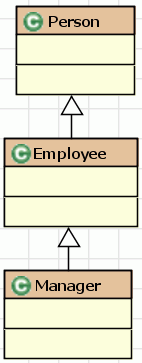1
2
3
4
5
6
7
8
9
10
11
12
13
14
15
16
17
18
19
20
21
22
23
24
25
26
27
28
29
30
31
32
33
34
35
36
37
38
39
40
41
42
43
44
45
46
47
48
49
50
51
52
53
54
55
56
57
58
59
60
61
62
63
64
65
66
67
68
69
70
71
72
73
74
75
76
77
78
79
80
81
82
83
84
85
86
87
88
89
90
91
92
93
94
95
96
97
98
99
100
101
102
103
104
105
106
107
108
109
110
111
112
113
114
115
116
117
118
119
120
121
122
123
124
125
126
127
128
129
130
131
132
133
134
135
136
137
138
139
140
141
142
143
144
145
146
147
148
149
150
151
152
153
154
155
156
157
| function Person(first, last) {
if ( arguments.length > 0 )
this.init(first, last);
}
Person.prototype.init = function(first, last) {
this.first = first;
this.last = last;
}
Employee.prototype = new Person();
Employee.prototype.constructor = Employee;
Employee.superclass = Person.prototype;
function Employee(first, last, id) {
if ( arguments.length > 0 )
this.init(first, last, id);
}
Employee.prototype.init = function(first, last, id) {
Employee.superclass.init.call(this, first, last);
this.id = id;
}
```
可以看到,我们把初始化属性的操作提取出来放到了一个init函数中,这样做是为了方便在子类中调用。注意其中的"**Employee.superclass = Person.prototype;**",这里是一个技巧,方便下面在子类中调用父类的方法。
另一个需要注意的地方是"**Employee.superclass.init.call(this, first, last);**":对于所有对象中的方法来说,都可以通过两个方法来调用--"**call**" 和 "**apply**".
这里使用了**call**方法,其中第一个参数是将在调用的方法中访问的对象,后面的参数与调用方法的参数一致。
**apply**方法的使用与call大致一致,不同在于除了第一个参数外,后面是一个参数数组。
下面附上完整的例子和类图:
继承关系图如下:

代码:
```javascript
function Person(first, last) {
if ( arguments.length > 0 )
this.init(first, last);
}
Person.prototype.init = function(first, last) {
this.first = first;
this.last = last;
};
Person.prototype.toString = function() {
return this.first + "," + this.last;
};
Employee.prototype = new Person();
Employee.prototype.constructor = Employee;
Employee.superclass = Person.prototype;
function Employee(first, last, id) {
if ( arguments.length > 0 )
this.init(first, last, id);
}
Employee.prototype.init = function(first, last, id) {
Employee.superclass.init.call(this, first, last);
this.id = id;
}
Employee.prototype.toString = function() {
var name = Employee.superclass.toString.call(this);
return this.id + ":" + name;
};
Manager.prototype = new Employee;
Manager.prototype.constructor = Manager;
Manager.superclass = Employee.prototype;
function Manager(first, last, id, department) {
if ( arguments.length > 0 )
this.init(first, last, id, department);
}
Manager.prototype.init = function(first, last, id, department){
Manager.superclass.init.call(this, first, last, id);
this.department = department;
}
Manager.prototype.toString = function() {
var employee = Manager.superclass.toString.call(this);
return employee + " manages " + this.department;
}
|
